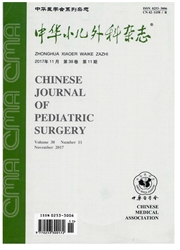

 中文摘要:
中文摘要:
目的分析影响肝母细胞瘤患儿综合治疗预后的危险因素。方法回顾性分析2001年5月1日至2012年1月30日本院收治的136例肝母细胞瘤患儿临床和病理资料及随访112例信息,治疗以手术加化疗为主,化疗分为术前化疗和术后化疗。随访时间35.6(3~144)个月。应用Kaplan-Meier曲线和Log-Rank检验进行生存分析,Cox比例风险回归模型进行单、多因素分析。采用SPSS19.0软件进行统计学分析。结果112例患儿中肿瘤中位直径(8.4±3.1)cm(2.9~19.0cm),AFP中位水平(6453.8±47699.2)μg/L(12.9~484000.0μg/L),肿瘤PRETEXTⅠ、Ⅱ、Ⅲ、Ⅳ分期为3例(2.7%)、16例(14.3%)、42例(37.5%)、51例(45.5%),单发肿瘤96例(85.7%)。多发肿瘤16例(14.3%),有远处转移者27例(24.1%),无远处转移者85例(75.9%)。肝母细胞瘤患儿血管侵犯者25例,其中门静脉侵犯17例(68%),腔静脉侵犯8例(32%)。K-M生存曲线分析显示,影响肝母细胞瘤患儿预后的危险因素包括AFP水平、PRETEXT分期、肿瘤单发多发、有无转移和血管侵犯。患儿血清甲胎蛋白(AFP)〈100μg/L或〉10000μg/L组(61例)5年生存率为47%(28例/61例)较AFP在100~10000μg/L组(51例)71.3%(36/51)低;肿瘤多发组(16例)5年生存率为25.9%(4/16)较单发组(96例)68.8%(66/96)低;PRETEXTⅣ期高危组(51例)患儿5年生存率为41.8%(21/51)较PRETEXTⅠ、Ⅱ、Ⅲ期标准组(61例)71.7%(44/61)低;有转移组(27例)5年生存率为24.3%(6/27)较无转移组(85例)67.9%(57/85)低;有血管侵犯组(25例)5年生存率为35%(9/25)较无血管侵犯组(87例)64.3%(56/87)低。Cox比例风险回归模型多因素分析显示AFP〈100μg/L或〉10000μg/L(HR2.454,95%CI1.207~4.987,P=0.013?
 英文摘要:
英文摘要:
Objective To analyze the prognostic factors of hepatoblastoma (HB) after comprehensive treatment. Methods Between May 1,2001 and January 30,2012, retrospective analyses were conducted for 136 cases of pediatric hepatoblastoma. Their clinicopathologieal data and follow-up information were collected and analyzed. The treatment regimen was composed mostly of surgery plus chemotherapy. And chemotherapy was divided into preoperative and postoperative chemotherapies. For 112 cases, the follow-up period was 35.6 (3-144) months. Kaplan-Meier curve and Log-rank test were employed for survival analysis. Cox proportional hazard regression model was used for univariate and multivariate analyses. Statistical analysis was performed with SPSS 19. 0 software. Results The median diameter of HB was 8. 4 ± 3.1 (2. 9-19. 0) cm and the median AFP level 6 453. 8 ± 47 699. 2 (12. 9-484000. 0) μg/L. The PRETEXT stages were I (n = 3,2. 7%), II (n = 16, 14. 3%), III (n = 42,37. 5%) and IV (n = 51,45.5%). There were single tumor (n = 96,85.7%) ,multiple tumors (n = 16, 14.3%), with distant metastasis (n = 27, 24. 1%) and without distant metastases (n = 85,75.9 % ). Vascular invasion occurred in 25 cases, including portal vein invasion (n = 17,68 % ) and vena cava infringement (n = 8,32%). K-M survival curve showed that prognostic factors of HB included level of AFP, PRETEXT staging, multiple single tumor, metastasis and vascular invasion. Serum alphafetoprotein (AFP)〈100 μg/L or AFP〉10 000μg/L (28/61,47%) had lower 5-year survival rate than 100μg/L 〈AFP〈10,000μg/L group (36/51,71.3%). And multiple tumors group (4/16, 25.9%) had a lower 5-year survival rate than single tumor group (66/96,68. 8%). As compared to PRETEXT stages I , II , III group(44/61,71.7%), PRETEXT IV stage group(21/51,41.8%)had a lower 5-year survival rate. The 5-year survival rate of metastasis group (6/27,24. 3%) was lower than that of metastasis group (57/85,67. 9%?
 同期刊论文项目
同期刊论文项目
 同项目期刊论文
同项目期刊论文
 Initial Experience of Single-Incision Laparoscopic Hepaticojejunostomy Using Conventional Instrument
Initial Experience of Single-Incision Laparoscopic Hepaticojejunostomy Using Conventional Instrument Conditional probability of survival in patients with biliary atresia after Kasai portoenterostomy: a
Conditional probability of survival in patients with biliary atresia after Kasai portoenterostomy: a 期刊信息
期刊信息
